The Larson 1750FX by Boats and More in Shepparton and Echuca is unreservedly a fishing machine that is built to perform and set up with the assistance of BLA, this incredible rig has the best of everything a lure fishing angler would want or ever need.
I had the pleasure last year to run around in the Larson FX1850DC, which is a bow rider that was also designed to become a very useable fishing rig. That boat was fantastic, but the FX1750 SC is a step up from this if angling is your priority – and let’s face it, if you’re like me, angling IS your priority when buying a boat.
The 1750FX rides exceptionally well, corners hard and is super stable when fishing, These factors have all been deliberately integrated into the design of the rig and Larson Boats has developed a process they term VEC, which is a computer-controlled manufacturing process used to produce every Larson VEC hull. The VEC process guarantees that every Larson VEC boat meets highly precise standards for quality and design.
This process produces incredibly precise hulls using a closed-molded composite lamination process. The result is a one-piece “uni-body” hull with an integrated composite stringer and transom system that is stronger, lighter and more robust—so you experience a fast, dry and quiet ride. All this means there is no wood used in the construction of the rig so no rotting, and also there are few joins or weak spots, meaning the company can offer an extended warranty with ease because they are very confident in their product.
On the water the 1750FX was a real buzz to drive around. Set up with a Mercury 150 4-stroke, the 1750FX fair hammered along getting over 42 knots at wide open throttle. We tested this rig on a day when there was only a little wind ruffle on Lake Mulwala, however there was a local fishing comp occurring when we tested the rig and the number of boat wakes to play around on was endless. We skipped over wakes on all angles and not once did the rig feel like it wanted to takes its own path over the rough stuff. This is encouraging as the last thing you want is a boat that dictates to you where it will run, especially if you’re fishing this rig in a larger estuary where chaotic wind, swell and boat wakes make navigation somewhat interesting. The higher sides also give you a sense of safety as well.
Cornering on this boat is interesting for the first few times. Like the bigger Larson tested last year, the 1750 rolls over a little more than Aussie tinnies do. It’s not dangerous or a worry and in fact the 1750 drives much more like a ski boat than the traditional tinnie.
Corners at speed are great fun. We went for a longer drive up the Murray River at cruising speed (around 4500rpm) and winding your way up and down the Murray was great. In this instance there was little roll over when compared to the tight figure of eight tests we did in the lake.
As a boat to get you places fast and safe, this will do just that.
What is there to say about the internal layout of this rig other than sensational?
All hatches are waterproof and there is so much storage in this boat that you could literally store a small tackle store’s worth of gear inside.
The rod locker in the Larson is awesome. I really like it a lot. Room for half a dozen rigged rods in the central compartment is brilliant. Do I sound enthusiastic about it? I hope so, because I love it.
On the skipper’s or starboard side of the front deck is a very useful tackle storage locker. This has an insert with pre-molded lugs to accept tackle trays. I find this system fantastic as I generally store my using tackle in Plano trays and take the trays I need. On the test day I took a Plano Spinnerbait box and three other tackle trays with diving lures from small golden perch sized snacks through to the mega-sized cod trollers. The ability to store all of this below decks is great.
On the port side opposite the tackle storage locker is a small live bait well. Talking to Shawn Clancy about this he could see this being used either as a livebait tank or as a storage site for the largest of your fish in a tournament. It’s certainly big enough to hold a couple of 1.5kg bream or bass and would be an easy way to keep tabs on your big fish for the comp.
In front of these two lockers are two general storage lockers that run up each side. These store things such as life jackets, safety gear and also other odds and ends such as the Minn Kota foot control, ropes and tackle retriever.
In the cockpit area the dash is set up with plenty of space for all the important gauges, however the addition of the Humminbird Onix means that you can link the sounder to your engine management system and have all the important engine data displayed on your sounder screen if you want. As for the Onix sounder – well it’s big and was mounted to the right hand side of the console on the biggest RAM bracket I have seen. It worked well in this position and was within easy reach of the skipper.
Seating is adjustable in four spots. We had three seats on board with us and this worked well with two seats on the port side and the skipper’s seat behind the console. The seating is comfortable, sturdy and they fold down for travel and storage. Good seating in a speed machine like this is hugely important and Larson has it pretty well covered.
At the stern end there is a massive livewell that will please any tournament angler, plus another storage space. When all the rear hatches are closed, the rear deck is another fishing platform, however this was somewhat compromised by the Humminbird 360 and Talon anchor spike posts that would get in the way of serious angling form the back deck. Not a problem though as the front deck is massive enough for three anglers anyway!
A list of internal features reads a little like this: bow storage compartments (4) with latches; lockable side storage (2); drink cup holder (3); aerated stern livewell (110L/48") with light; trolling motor battery storage compartment (12/24 Volt) located under mid rod storage locker; centre lockable rod storage for 8 rods to 7’6”; and 6 seat positions. Now that’s a lot of features without including the moveable accessory mounts and heaps of other neat ideas!
Fully powered with the amazing Mercury 150hp EFI 4-stroke, the Larson was a real piece of eye-candy on the trailer and on the water.
But it’s not all about beauty as this outboard has plenty of the right stuff when it comes to power. As the outboard was new (the rig had been set up for only 2 weeks) you can expect the speed figures to alter a little, but the 150 Merc got the FX1750 SC flying at 42 knots at WOT. Keep in mind that on a lot of waterways a maximum of 40 knots is allowed so the 150 Merc has more than enough of the good stuff to get you where you need to go fast.
The beauty of this outboard on the Larson is that the Mercury provides a lot of plusses. For starters it’s a very light unit for a 4-stroke at around 206kg. Any weight saving on the rear end is a good weight saving. The 150hp Merc is also very fuel efficient and with the Larson cruising easily at 4,500RPM and around 33knots, fuel use will be minimised and the range of cruising will be extended.
Like all 4-strokes the noise in the boat was minimal until you had the outboard under stress at take off when the outboard got down and dirty and powered the boat quickly onto the plane in under 4 seconds. I always think about engine noise at top end, but in all seriousness, we were going so fast that all I could hear was the wind in my ears. At idle you could barely hear a whisper from the outboard and as we putted around the various snags and channels in Mulwala we could hold a conversation easily.
So while you could go for a less powerful outboard, I am always a fan of upping the ante where you can. More power in your outboard is always a good thing if you need it and with this boat set up as a tournament beast, getting to and from the start/finish area at speed is a must.
The Larson was trailered on a Dunbier tandem trailer that was fully rollered and set up for drive on and drive off capabilities. On the road this set up worked brilliantly and I had no trouble at all getting the boat from Shepparton through to Mulwala and back.
But trailers, while most importantly getting your boat safely to and from the water, are usually judged on their ability to launch and retrieve a boat and the Dunbier did it easily. At launch the rig slid from the rollers easily with out going so fast that anything behind you is in serious peril. This is good because some trailers that are fully rollered really do allow the boat to fly off way too quickly. On retrieve the boat can be gently driven into position and from there easily driven up the trailer and secured up front. You can actually do it over the bow of the boat if you have to and we did this the first time we launched and retrieved her, but ideally you make sure the car driver has to do his or her part in retrieval as well.
Make no mistake this is a big boat with the need to have a car capable of towing it easily. I towed it around with a VW Tiguan (around 3,000kg towing ability) but most big sixes and 4WDs of just about any size will comfortably get this boat to and from the water.
This is for me the real test of any boat. It’s all great to be fast, safe and wonderful over the chop, but if it is hard to fish from, well then the rig becomes a family cruiser and not a fishing boat.
As this was a real boat test we spent three hours having a fish from the boat. Apart from the ease of fishing with its massive front deck and stability, the BLA products (more on these later) made everything almost too simple. Under electric power, the Larson was responsive to the bow mounted Minn Kota and I was able to manoeuvre the rig into and around snags and weed beds quite easily. Up front Simon and Pete were fishing hard and were largely undisturbed by my manoeuvring and even when the inevitable wake board boat’s wake crashed trough our fishing area, the boys up front were not tipped out into the drink –more’s the pity.
Accessing gear is simple too. With such a large front deck you could access the tackle storage locker easily and change lures while still on the front deck and not disturb the other person fishing on the front deck. That was great. When casting at snags, we had both anglers on one side of the boat and I was also on the same side driving the electric by foot control and there was no disturbing lean over that made you uncomfortable. That was great too.
When the boys did finally hook the odd fish, the inevitable rush towards the side of the boat the fish was on saw us all crowding the angler out and around 300kg concentrated in one spot – again there was very little noticeable lean, however I will concede that in the heat of battle you’re not really looking at how much the boat is leaning over. But the high sides of the FX1750 SC give you a real feeling of safety and that was good too.
Of course the fishing was made easier by the fact that BLA had kitted this rig out and let’s take a look at some of that gear.
The tested FX1750 SC has been kitted out by BLA as a bit of a show boat. This rig will tour the tournament circuits and be available for all and sundry to climb all over, check out and get to know just what you can do in terms of electronics and accessories.
Let’s start at the bow and journey down to the stern.
First up is the fabulous Minn Kota Riptide i-Pilot link 80lb, 24V unit. This is exactly the same electric I have on my boat and I can’t speak highly enough of it. Spot Lock, waypoint memory, track memory, the best foot control I have seen and also a remote, plenty of power – yeah I love this bit of kit. The important part of this electric is th link system. This electric motor ha the ability to link to the sounder, in this case the brand new Onix touch, and allows thee electric to be used from the sounder. From the sounder you can mark a way point and then tell the electric to go there. You can also adjust speed and direction and a host of other things that mean if you run out of battery power on your remote, the electric is still useable.
Up front a 7”-10” sounder is planned to be fitted to give the front deck caster all the information they need. This wasn’t rigged up when we tested the boat, but when it’s installed it will be like watching a TV show on what’s below/
The new Onix sounder is a fair dinkum weapon. It’s big, bold and very easy to use. With the ability to run multiple screens on the main screen you can run standard sounder features, GPS, down scan and side imaging all on the one screen to any combination of these. This boat was rigged up with the very impressive Humminbird 360 and this gives you an unfair advantage. We played around with this in Mulwala around areas I thought I knew pretty well and the snags you discover by just looking are a bit scary. For example you can find a snag and know roughly how far away it is and in what direction from the boat it is. The 360 allows you to stand off on a snag (or any feature for that matter) and know where to cast to cover it properly. I am sure better sounder users than I will use the power of the Onix to isolate fish with the 360 and really do some serous fishing. I can’t wait to see what happens as users come to grips with this immense power.
The Onix is a combination of touch and manual controls. You can literally do everything by touch screen and everything by manual controls. It’s a great way to ease users into touch screen technology and I found myself using both almost intuitively. It’s very simple to use and after a quick lesson from Shawn Clancy we had no trouble operating the unit in the field. A few months getting to know the unit better and working out the settings for your fishing would give you a frighteningly good piece of technology.
Down at the stern end there were two rear arms fitted. The one on the starboard side belonged to the Humminbird 360 transducer and the one on the right belonged to the Talon anchor spike. Anchor spikes are an interesting piece of equipment and after mucking around with on in Mulwala I am keen to explore them a bit more. Basically the Talon anchor spike is a spike that deploys into the substrate and acts as an anchor. This is sensational. With the low flows of the lake, the Talon provide us a way to fix ourselves into position while fishing without me having to jiggle and juggle the electric. Simply spike down, either with the remote or the front foot control, and keep fishing. While the flows were low in late April in the Murray, the Talon’s strength was never really tested, however I am assured that this beast of an anchor spike can hold this rig in substantial current and wind. I found that if I got the placement wrong, something I did a little too often at first, then I could leave the anchor spike in position and rotate the bow of the boat with the electric to hold the anglers in the best casting position. Seriously, this set up is frighteningly good.
So are all these accessories worth it? Absolutely. I get that not everyone will have the coin for these accessories, but having had just a bit of exposure to them, they simply make you want more. It’s like red wine was explained to me, if you are left wanting just a little more, then the wine is worth the price, and I can tell you, this wine was worth the price.
The FX1750 SC is a brilliant rig with so many features that are simply amazing to use in the field. The ride quality is outstanding, the way this boat fishes is great and the overall features and finish on the boat make this a serious contender for anyone looking for a tournament style fishing rig with some serious credential.
If you want to know more about the FX1750 SC, and I suggest you all find out more, give the team at Boats and More in Shepparton (03 5822 2108 or Echuca (03 5482 1992) a call or log onto www.boatsandmore.com.au and do some of your own research.
The base price with a 125hp Optimax starts at $43,999. The price as tested was $73,490, and if you want the project boat fully fitted with all that fancy kit it costs $76,990.
If you’re in the market for a hell of a boat, check out the Larson FX1750 SC. It’s a very impressive piece of fishing weaponry.
Speed at RPM
| RPM | Speed (knots) |
|---|---|
| Idle | 2.3 |
| 1,000 | 3.2 |
| 2,000 | 6.3 |
| 3,000 | 18.3 |
| 4,000 | 29.5 |
| 5,000 | 36.5 |
| WOT (5,800) | 42 |
Specifications
| Approximate Weight (with 115hp) | 907kg |
|---|---|
| Beam | 2.44m |
| Cockpit Depth | 0.61m |
| Deadrise | 16 deg |
| Fuel Capacity | 83.27L |
| Hull Type | VEC |
| Length-Centerline | 5.31m |
| LOA on Trailer | 5.97m |
| US Max. Weight Capacity | 680kg |
| Max. Horsepower | 150hp |
| Person Capacity | 5 |
| Transom Height | 25" (0.64m) |
| Towing | Large 6 cylinder of 4WD |
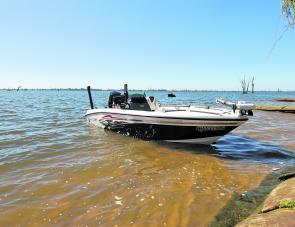
As pretty as a picture, the Larson FX1750 SC is a dream ride in just about every sense of the word.
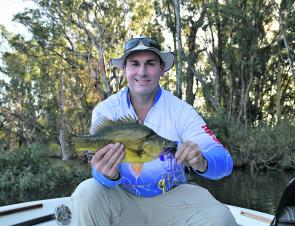
Simon __________ from Boats and More was a very willing participant in this boat test. He nailed this neat golden perch on a spinnerbait wile we were poking around the timber of Mulwala.
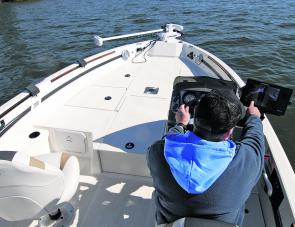
The front deck is massive, easily able to fit 3 anglers and four at times. The console is set up with a Humminbird Onix sounder and it’s in easy reach for the skipper.

Looking towards the transom sees the ability for four seat positions plus the powerful Talon anchor spike and the Humminbird 360 transducer. The rear end is a wealth of technology that will help you catch more fish.
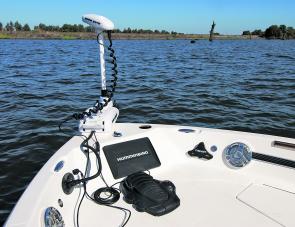
Up at the bow you’ll find the Talon anchor spike control (to the starboard or right hand side) as well as the impressive Minn Kota iPilot link system and there is room for a 7” or 8” second sounder.
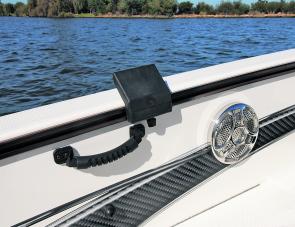
Arouns the gunwales you’ll find moveable mounts for things like downriggers, rod holders and more. This is a really neat way to allow you to customise your positioning of accessories to suit how many anglers you have and what you are doing on the day.
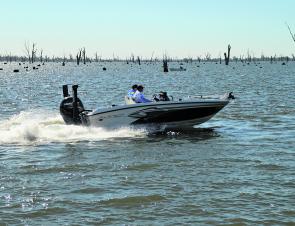
At full flight the Larson is a weapon of speed and style. If you need to get somewhere quickly, this baby will do it easily.
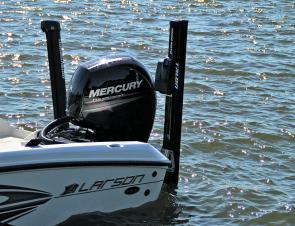
The powerful Mercury 150hp 4-stroke is an ideal match for this rig. It’s the top of the ratings for power, but after giving it a good run, it’s the option I would look at.
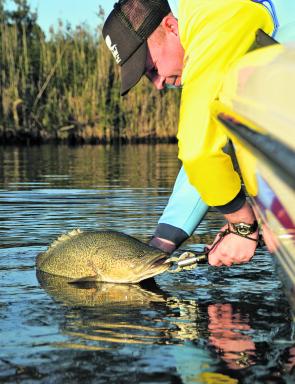
This 75cm Murray cod was taken in Mulwala when we were testing the Larson. This boat fishes exceptionally well and we could move in and around the snags and weed beds with surprising ease.

Peter Jung used the Larson on our test day to nail this 54cm golden perch on a spinnerbait. With two fishing up front it was a dream boat to fish from.




